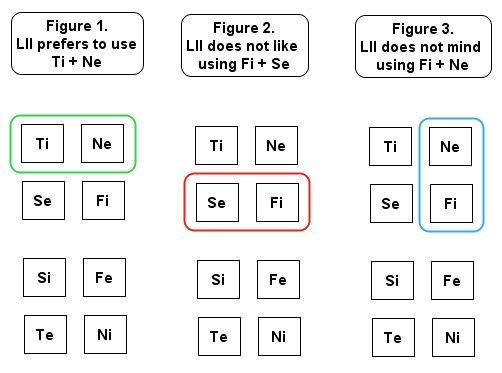Model B proposes that each Information Element can be divided into two versions: a "plus" version (also known as "expanding") and a "minus" version (also known as "reducing"). To hold these sixteen elements, Model B proposes a sixteen-function information metabolism model. In addition to the regular "Model A", it proposes a second layer of personality called the "Shadow". The Shadow is a duplicate of Model A, containing the opposite-polarity versions of the Information Elements.
(Note that the above diagram from Bukalov's website contains an error: the polarities ofin the left-most figure should be reversed.)
For example, in Model B an LII has -Ti and +Ne in his Ego, and +Ti and -Ne in his Shadow Ego. He has -Fe and +Si in his Super-Id, and +Fe and -Si in his Shadow Super-Id, etc.
When an element of one polarity is valued, the other polarity is unvalued. Consequently, the Ego contains strong valued functions, while the Shadow Ego contains strong unvalued functions; the Super-Ego contains weak unvalued functions, while the Shadow Super-Ego contains weak valued functions, etc. So an LII would value -Ti, +Ne, -Fe, +Si, +Fi, -Se, +Te, -Ni, and would not value +Ti, -Ne, +Fe, -Si, -Fi, +Se, -Te, +Ni.
The plus and minus versions of the IEs are often dismissed as being another way of saying which element they're blocked with: -Ti being Ti blocked with Ne, and +Ti being Ti blocked with Se, etc. But in Model B, this is not always the case. In the Shadow, -Ti is sometimes blocked with +Se, and +Ti with -Ne. This is sometimes pointed to as evidence that plus/minus is more than just a different way of stating which element is blocked with which, and that it in some way reflects an intrinsic property of the elements themselves.
In my experience, the observable portions of the Model B hypothesis seem to be borne out pretty well. LIIs do seem uncomfortable with strong expressions of +Fe, and do tend to advocate behaviour matching +Fi. SLIs do seem largely uninterested in +Si, and to some degree appreciate -Ti input. And so on. However, recently I have begun to think that there is a way to explain these observations without resorting to a second layer of personality as Model B does.
The idea is pretty simple. We prefer to use our valued functions, and prefer not to use our unvalued functions unless we really have to. An LII prefers to use Ti + Ne, and finds using Fi + Se to be uncomfortable. And we know that Information Elements are used in pairs. So when we are using an unvalued function, it seems to me that we would have a tendancy to pair it with a valued function rather than an unvalued one. After all, why use two unvalued functions when you can get away with using only one?
In the case of an LII, when he finds it necessary to deal with Fi matters, he would tend to find it preferable to pair his unvalued Fi with his valued Ne, rather than his unvalued Se. Or when an LII has to deal with Se matters, he would find it less objectionable to pair his Se with Ti instead of Fi. Conversely, LII values Ti, but prefers to pair it with Ne, finding the pairing of Ti with Se to be strange and less comfortable. In this way, we arrive at a picture of an LII who strongly values Ti+Ne, strongly devalues Fi+Se, and sort of half-values Fi+Ne and Ti+Se. This eliminates the need for Model B's second layer of personality, and in my opinion actually matches the observable behaviour of types more closely, by introducing a level of value between "valued" and "unvalued".
Unless there are additional aspects of Model B that I am not aware of, I believe that my theory fully explains all plus/minus related phenomena without resorting to adding Model B's second layer of personality. In fact, I wouldn't be surprised if someone else had proposed this idea before, although if someone has I have not yet seen it anywhere.
I'm interested in your opinions and observations on this matter.





 Reply With Quote
Reply With Quote

 :" hitting cap makes me envision cervix smashing"
:" hitting cap makes me envision cervix smashing"





